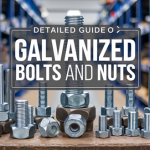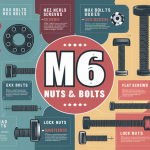Today many fasteners are used for the aim to secure joining metals and materials together. Both nuts and bolts come in as many shapes and designs. The majority of bolt types, have machine threads. The purpose of a threaded bolt is to hold or secure things together by attaching it into nuts. Bolts may be broken down into three categories: eye bolts, wheel bolts, and machine bolts. Nuts can be further divided to 3 groups: cap nuts, extension nuts, and u-nuts. The strategy and functionality of different types of fasteners are also influenced by the kinds of material and finish used.
This article will provide you with information on the many Types of nuts and bolts, as well as the various kinds of its heads.
What are the types of bolts?
These bolts is normally used with nuts and washers. Bolts are made in mixed sizes and the width of the bolt rises with length. Bolts comes with heads and threaded parts known as shanks. The size of a bolt is connected with the diameter of the shank and the length. Bolt types include:
Carriage Bolts:
- Domed, inflated head shape
- Made to keep bolt from pulling it
- Connects wood and metal to wood
U-Bolts:
- The shape of it is like a U that has threaded on both sides connected to nuts
- It attaches rope, chain, auto features and pipework
Lag Bolts:
- This is called as lag screws and does not have any nut
- It is tremendously durable, best for bearing large loads
- First-rate for floor tiles and gardens
Structural Fasteners:
- It comes in many sizes, from lesser than a millimetre to larger than 20 inches long
- It is applied in many industries and objects such as plastics products and composites
- Amazing standby for old-style lag and carriage bolts
- It is cheap and simple to use choice for the specialists.
Eye Bolts:
- It is applied for rigging, attaching, dragging, to push objects and lifting apps
- Two types are forged or bending into a single kind of piece
Applications of Nuts and Bolts
Fasteners that are essential for many sectors and applications include nuts and bolts. Here are a few common applications and uses for nuts and bolts:
- Building: In the building industry, nuts and bolts are an essential tool.
- Automobile: Nuts and bolts are often utilized to join several components in the automobile industry.
- Manufacturing: Nuts and bolts are often utilized in manufacturing operations such the creation, assembly, and manufacture of machinery.
- Aerospace: In many of the present aviation sector tight tolerances are required for fasteners.
- Woodworking and Furniture: All of the todays designs such as cabinets, sofas furniture, and different woodworking items are built with these nuts and bolts.
Types of Hardware Nuts
Nuts are a kind of fastener that have threaded holes and are used to secure bolts, screws, or studs to ensure that components are held together. Once a nut has been tightly tightened, it restricts axial movement in materials that are attached to it.
Cap Nuts:
- Also known as the acorn nut, it comes with domed top
- Caps the unprotected tops of shafts, axles and rods
Hex Nuts:
- 6 sided, it is applied numerous threaded applications
- There are Finished hex, semi-finished hex, hex flange and slotted hex
Jam Nuts:
- Standard hex nuts are half as long as these nuts.
- It keeps places lock. It does not clamp to a different object
Lock Nuts:
- It is called as nylon lock nuts or usual torque nuts
- Used with different nuts to stop them from releasing
Push Nuts:
- Can be capped or uncapped, installed with a special nut driver
- Removal will destroy fastener
Coupling Nuts:
- Resonating threaded fastener, also known extension nuts
- Joins two male nut threads, driven with a wrench. It ios used for piping and construction
Speed Nuts:
- It is famously known as sheet metal nut
- Has two metal pieces that function as one. It is applied in furniture and agriculture
Square Nuts:
- Threaded nut with four sides. It is used in industry areas and objects made of metals
- It comes with many interior plating’s all over
T-Nuts:
- It looks like a longer threaded body
- Normally with 3 or 4 points to sink into material for best holding
Flange Nuts
- Flange nuts feature a wide flange that acts as an integrated washer
- It distributing the load over a larger area and reducing the risk of damage to the surface beneath.
- They are often used in applications where vibration is a factor, as the flange helps prevent loosening and provides extra stability.
Wing Nuts
- Wing nuts are easily recognizable by their two “wings” that allow for hand tightening without the need for tools.
- This makes them ideal for applications requiring frequent adjustments or quick assembly, such as in furniture assembly or temporary fixtures.
- Their unique design offers convenience, though they may not be suitable for high-torque applications.
Common Bolt Materials
There are several various types of materials which might be used to make bolts and nuts. There are metals and plastics among these available materials. Stainless steel material is tough and resistant to corrosion. Today polymer choices are not as strong as stainless steel, they are an outstanding choice for using in biochemical resistance. The following are the often seen materials:
- Stainless steel
- Alloy steel
- Low carbon steel
- carbon steel
- Titanium
- Polymers, like the nylon
Bottom Line
Remember that the correct hardware can create all the difference. Nut Bolt Manufacturers India play an essential role in today world. They give the essential hardware that holds apparatus, structures, and daily products together. These makers make use of advanced technologies and good quality materials to design an extensive range of fasteners.
Read Also:






